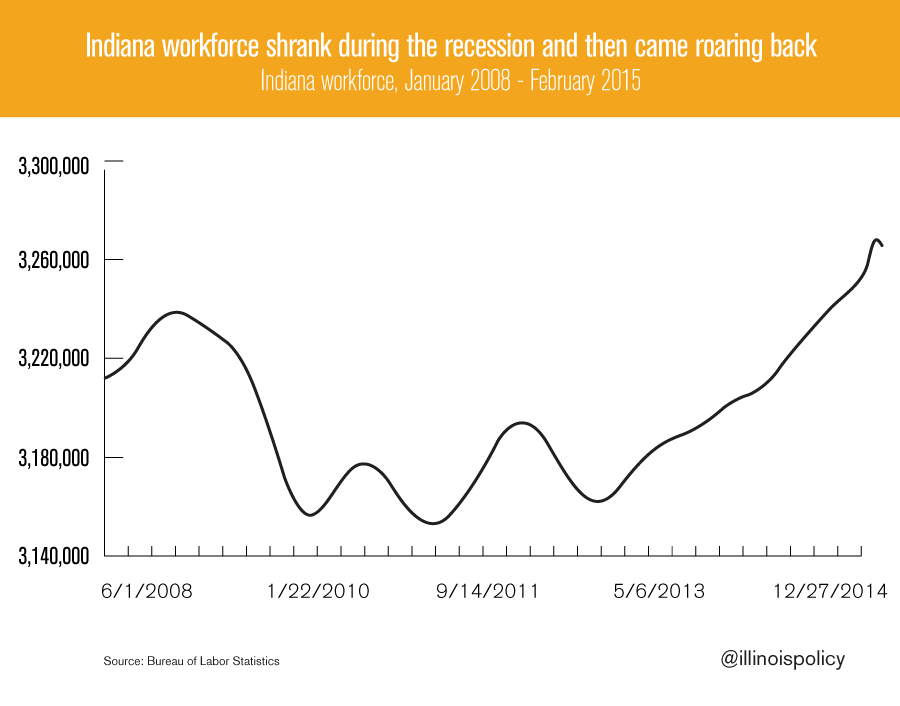Illinois unemployment problems hidden by workforce dropout
Over the recession era, Indiana’s workforce grew by 53,000 people while Illinois’ workforce shrank by 200,000 people. If Illinois’ workforce size were benchmarked to Indiana’s over the recession era, Illinois’ unemployment rate would be 10.3 percent today.
Illinois’ unemployment crisis has been masked by residents dropping out of the workforce. When people stop looking for work, they are not counted as “unemployed” by the Bureau of Labor Statistics. This makes the unemployment rate appear lower, covering up the clear need for structural reform.
The official data from the Bureau of Labor Statistics put Illinois’ jobless rate at 6 percent to Indiana’s 5.9 percent. The reason the jobless rates are similar is because so many unemployed Illinoisans have dropped out of the workforce and are no longer counted among the jobless. Over the recession era, Indiana’s workforce grew by 53,000 people while Illinois’ workforce shrank by 200,000 people. If Illinois’ workforce size were benchmarked to Indiana’s over the recession era, Illinois’ unemployment rate would be 10.3 percent today.
Even though Illinois’ working-age population has grown by 300,000 over the recession era, Illinois’ workforce has shrunk by 200,000, a 3 percent drop in workforce size. Even more troubling is the fact that Illinois’ workforce is still contracting, likely contributing to the state’s record year of out-migration last year.
 Indiana’s workforce also shrank at the beginning of the recession, but has since bounced back with a vengeance. Workforce growth in the Hoosier State especially ramped up after Indiana enacted a statewide Right-to-Work law, which went into effect in March 2012. On net, Indiana’s workforce has grown by 53,000 over the recession era, a gain of 1.7 percent, in line with a 1.8 percent growth in the national workforce.
Indiana’s workforce also shrank at the beginning of the recession, but has since bounced back with a vengeance. Workforce growth in the Hoosier State especially ramped up after Indiana enacted a statewide Right-to-Work law, which went into effect in March 2012. On net, Indiana’s workforce has grown by 53,000 over the recession era, a gain of 1.7 percent, in line with a 1.8 percent growth in the national workforce.
Indiana and Illinois faced similar fates during the economic downturn of the Great Recession. Both states achieved their pre-recession employment peak in January 2008. Then the downturn hit, and Indiana fell slightly harder than Illinois during the two years of job losses. The number of people working in Indiana fell by 7.9 percent compared to Illinois’ 7.5 percent loss, while both state workforces shrank by 1.7 percent.
Since bottoming out, the Hoosier recovery has far outpaced Illinois’ anemic growth. From the recession bottom, total Hoosier employment has grown by more than 9 percent, compared to only 4 percent growth for Illinois. And while Indiana’s workforce has expanded by 3.5 percent during the recovery, Illinois’ has contracted by another 1.6 percent. The Illinois workforce sustained a net loss of another 105,000 workers during the economic recovery period.

The Hoosier playbook contains several policy advantages over Illinois, which makes it important for policy leaders in Illinois to come up with innovative and competitive solutions. A critical part of becoming competitive is for Illinois cities to stop losing manufacturing opportunities to Indiana. Workers’ compensation reform is necessary to compete for manufacturing jobs, and Illinois municipalities can use Right-to-Work ordinances to compete for still more opportunities in manufacturing and other sectors.
Gov. Bruce Rauner has articulated critical structural reforms that are necessary to turn around the Land of Lincoln. In addition to those reforms, a statewide agenda for entrepreneurship can make Illinois the friendliest state in the region for starting up a new enterprise. Lawmakers have already started pushing the agenda for entrepreneurship by sunsetting the 2011 tax hikes and moving forward bills to enact the nation’s most competitive framework for investment crowdfunding, repeal the harmful death tax, and reform small business taxes and fees .
It’s been a long economic winter in Illinois. But new leadership in Springfield means that Illinois will have the opportunity to transform from a state where problems are hidden behind massive out-migration and workforce dropout into a destination state of growth, innovation and in-migration.
Image credit: clarkmaxwell



